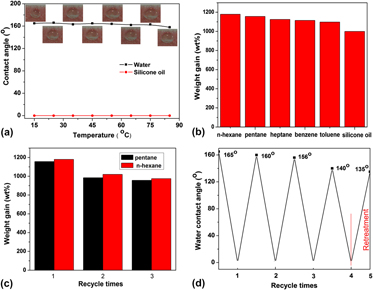Crossref Citations
This article has been cited by the following publications. This list is generated based on data provided by
Crossref.
Fan, Wenjie
Liu, Xuefei
Zhang, Zhen
Zhang, Qijian
Ma, Wei
Tan, Dazhi
and
Li, An
2014.
Conjugated microporous polymer nanotubes and hydrophobic sponges.
Microporous and Mesoporous Materials,
Vol. 196,
Issue. ,
p.
335.
Rezaei, Sasan
Manoucheri, Iraj
Moradian, Rostam
and
Pourabbas, Behzad
2014.
One-step chemical vapor deposition and modification of silica nanoparticles at the lowest possible temperature and superhydrophobic surface fabrication.
Chemical Engineering Journal,
Vol. 252,
Issue. ,
p.
11.
Zhang, Zheng
Sèbe, Gilles
Rentsch, Daniel
Zimmermann, Tanja
and
Tingaut, Philippe
2014.
Ultralightweight and Flexible Silylated Nanocellulose Sponges for the Selective Removal of Oil from Water.
Chemistry of Materials,
Vol. 26,
Issue. 8,
p.
2659.
Wu, Lei
Zhang, Junping
Li, Bucheng
and
Wang, Aiqin
2014.
Magnetically driven super durable superhydrophobic polyester materials for oil/water separation.
Polymer Chemistry,
Vol. 5,
Issue. 7,
p.
2382.
Wu, Lei
Zhang, Junping
Li, Bucheng
and
Wang, Aiqin
2014.
Mechanical- and oil-durable superhydrophobic polyester materials for selective oil absorption and oil/water separation.
Journal of Colloid and Interface Science,
Vol. 413,
Issue. ,
p.
112.
Li, Beibei
Liu, Xiaoyan
Zhang, Xinying
Zou, Junchen
Chai, Wenbo
and
Lou, Yanyan
2015.
Rapid adsorption for oil using superhydrophobic and superoleophilic polyurethane sponge.
Journal of Chemical Technology & Biotechnology,
Vol. 90,
Issue. 11,
p.
2106.
Ge, Bo
Men, Xuehu
Zhu, Xiaotao
and
Zhang, Zhaozhu
2015.
A superhydrophobic monolithic material with tunable wettability for oil and water separation.
Journal of Materials Science,
Vol. 50,
Issue. 6,
p.
2365.
Wu, Lei
Li, Lingxiao
Li, Bucheng
Zhang, Junping
and
Wang, Aiqin
2015.
Magnetic, Durable, and Superhydrophobic Polyurethane@Fe3O4@SiO2@Fluoropolymer Sponges for Selective Oil Absorption and Oil/Water Separation.
ACS Applied Materials & Interfaces,
Vol. 7,
Issue. 8,
p.
4936.
Wang, Huaiyuan
Wang, Enqun
Liu, Zhanjian
Gao, Dong
Yuan, Ruixia
Sun, Liyuan
and
Zhu, Yanji
2015.
A novel carbon nanotubes reinforced superhydrophobic and superoleophilic polyurethane sponge for selective oil–water separation through a chemical fabrication.
Journal of Materials Chemistry A,
Vol. 3,
Issue. 1,
p.
266.
Wang, Ben
Liang, Weixin
Guo, Zhiguang
and
Liu, Weimin
2015.
Biomimetic super-lyophobic and super-lyophilic materials applied for oil/water separation: a new strategy beyond nature.
Chemical Society Reviews,
Vol. 44,
Issue. 1,
p.
336.
Li, Beibei
Liu, Xiaoyan
Zhang, Xinying
Chai, Wenbo
Ma, Yining
and
Tao, Jingjing
2015.
Facile preparation of graphene-coated polyurethane sponge with superhydrophobic/superoleophilic properties.
Journal of Polymer Research,
Vol. 22,
Issue. 10,
Chowdhury, Subhendu Ray
Jha, Atanu
Manna, Uttam
and
Sarma, K. S. S.
2016.
Designing a single superabsorbent for separating oil from both layered as well as micron/submicron size emulsified oil/water mixtures by gamma radiation assisted grafting.
RSC Advances,
Vol. 6,
Issue. 31,
p.
26086.
Ge, Jin
Zhao, Hao‐Yu
Zhu, Hong‐Wu
Huang, Jin
Shi, Lu‐An
and
Yu, Shu‐Hong
2016.
Advanced Sorbents for Oil‐Spill Cleanup: Recent Advances and Future Perspectives.
Advanced Materials,
Vol. 28,
Issue. 47,
p.
10459.
Wilson, Runcy
Joy, Jithin
George, Gejo
and
Anuraj, V.
2016.
Advanced Environmental Analysis.
p.
456.
Zhang, Luhong
Xu, Lidong
Sun, Yongli
and
Yang, Na
2016.
Robust and Durable Superhydrophobic Polyurethane Sponge for Oil/Water Separation.
Industrial & Engineering Chemistry Research,
Vol. 55,
Issue. 43,
p.
11260.
Wang, Jintao
Geng, Guihong
Liu, Xiao
Han, Fenglan
and
Xu, Jixiang
2016.
Magnetically superhydrophobic kapok fiber for selective sorption and continuous separation of oil from water.
Chemical Engineering Research and Design,
Vol. 115,
Issue. ,
p.
122.
Xu, Zhaoyang
Zhou, Huan
Jiang, Xiangdong
Li, Jianyu
and
Huang, Fang
2017.
Facile synthesis of reduced graphene oxide/trimethyl chlorosilane‐coated cellulose nanofibres aerogel for oil absorption.
IET Nanobiotechnology,
Vol. 11,
Issue. 8,
p.
929.
Abraham, Eldho
Weber, David E
Sharon, Sigal
Lapidot, Shaul
and
Shoseyov, Oded
2017.
Multifunctional Cellulosic Scaffolds from Modified Cellulose Nanocrystals.
ACS Applied Materials & Interfaces,
Vol. 9,
Issue. 3,
p.
2010.
Pinto, J.
Heredia-Guerrero, J. A.
Athanassiou, A.
and
Fragouli, D.
2017.
Reusable nanocomposite-coated polyurethane foams for the remediation of oil spills.
International Journal of Environmental Science and Technology,
Vol. 14,
Issue. 10,
p.
2055.
Zhang, Yan Qiu
Yang, Xiao Bin
Wang, Zhen Xing
Long, Jun
and
Shao, Lu
2017.
Designing multifunctional 3D magnetic foam for effective insoluble oil separation and rapid selective dye removal for use in wastewater remediation.
Journal of Materials Chemistry A,
Vol. 5,
Issue. 16,
p.
7316.



